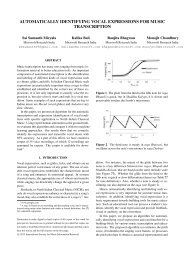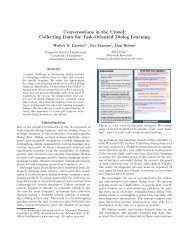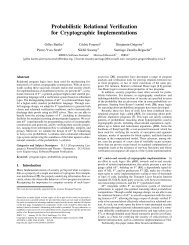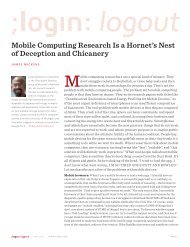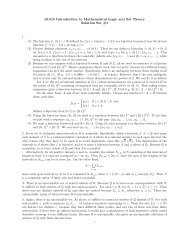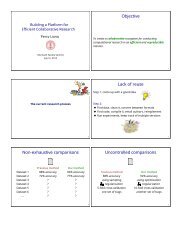On Intuitionistic Linear Logic - Microsoft Research
On Intuitionistic Linear Logic - Microsoft Research
On Intuitionistic Linear Logic - Microsoft Research
You also want an ePaper? Increase the reach of your titles
YUMPU automatically turns print PDFs into web optimized ePapers that Google loves.
§1. Sequent Calculus 11<br />
2. The cut rank of a proof π, is defined as<br />
c(π) def<br />
⎧<br />
0 If lst(π)=Identity<br />
⎪⎨ c(π1) If lst(π)=Unary rule<br />
= max{c(π1), c(π2)} If lst(π)=Binary rule<br />
⎪⎩<br />
max{|A| + 1, c(π1), c(π2)} If lst(π)=Cut<br />
with Cut formula A.<br />
3. The depth of a proof π, is defined as<br />
d(π) def<br />
=<br />
⎧<br />
⎨<br />
⎩<br />
0 If lst(π)=Identity<br />
d(π1) + 1 If lst(π)=Unary rule<br />
max{d(π1), d(π2)} + 1 If lst(π)=Binary rule.<br />
To facilitate the proof of cut-elimination 3 we find it convenient to replace the Cut rule with an<br />
indexed cut rule<br />
n<br />
<br />
Γ − A A, . . . , A, ∆ − B<br />
Cutn.<br />
Γ, . . . , Γ,<br />
∆ − B<br />
<br />
n<br />
It is clear that this is a derived rule 4 as it represents the sequence of Cut rules<br />
Γ − A<br />
n<br />
<br />
Γ − A A, A, . . . , A,∆ − B<br />
Cut<br />
Γ, A, . . .,A,∆ − B<br />
·<br />
Γ, Γ, . . .,A, ∆ − B<br />
Cut.<br />
Γ, Γ, . . . , Γ,<br />
∆ − B<br />
<br />
n<br />
Of course when n = 1 this rule is just the familiar Cut rule as before. It is clear that if we can<br />
prove a cut elimination theorem for this more powerful cut rule, then we have as a corollary the cut<br />
elimination theorem for the standard unary rule. (In what follows we shall use the abbreviation An to represent the sequence A, . . . , A.)<br />
<br />
n<br />
Lemma 1. Let Π1 be a proof of Γ − A and Π2 be a proof of ∆, A n − B and assume that<br />
c(Π1), c(Π2) ≤ |A|. A proof, Π, of Γ n , ∆ − B can be constructed such that c(Π) ≤ |A|.<br />
Proof. We proceed by induction on the sum of the depths of the two proofs, i.e. on d(Π1) +d(Π2),<br />
where Π1 and Π2 are the immediate subtrees of the proof<br />
Π1<br />
Γ − A<br />
Γ n , ∆ − B<br />
Π2<br />
A n , ∆ − B Cutn.<br />
There are numerous cases depending on the structure of Π1 and Π2.<br />
1. When the principal formula in the proofs Π1 and Π2 is the cut formula, A.<br />
3 In particular, without this trick of taking a multi-cut rule it seems difficult to find an inductive count that<br />
decreases if we keep a ‘single’ cut rule. It should be possible but, as far as my research has found, it seems to have<br />
eluded proof theorists so far.<br />
4 As it is a derived rule, it is simple to extend the notion of cut rank to handle an occurrence of the Cutn rule.



